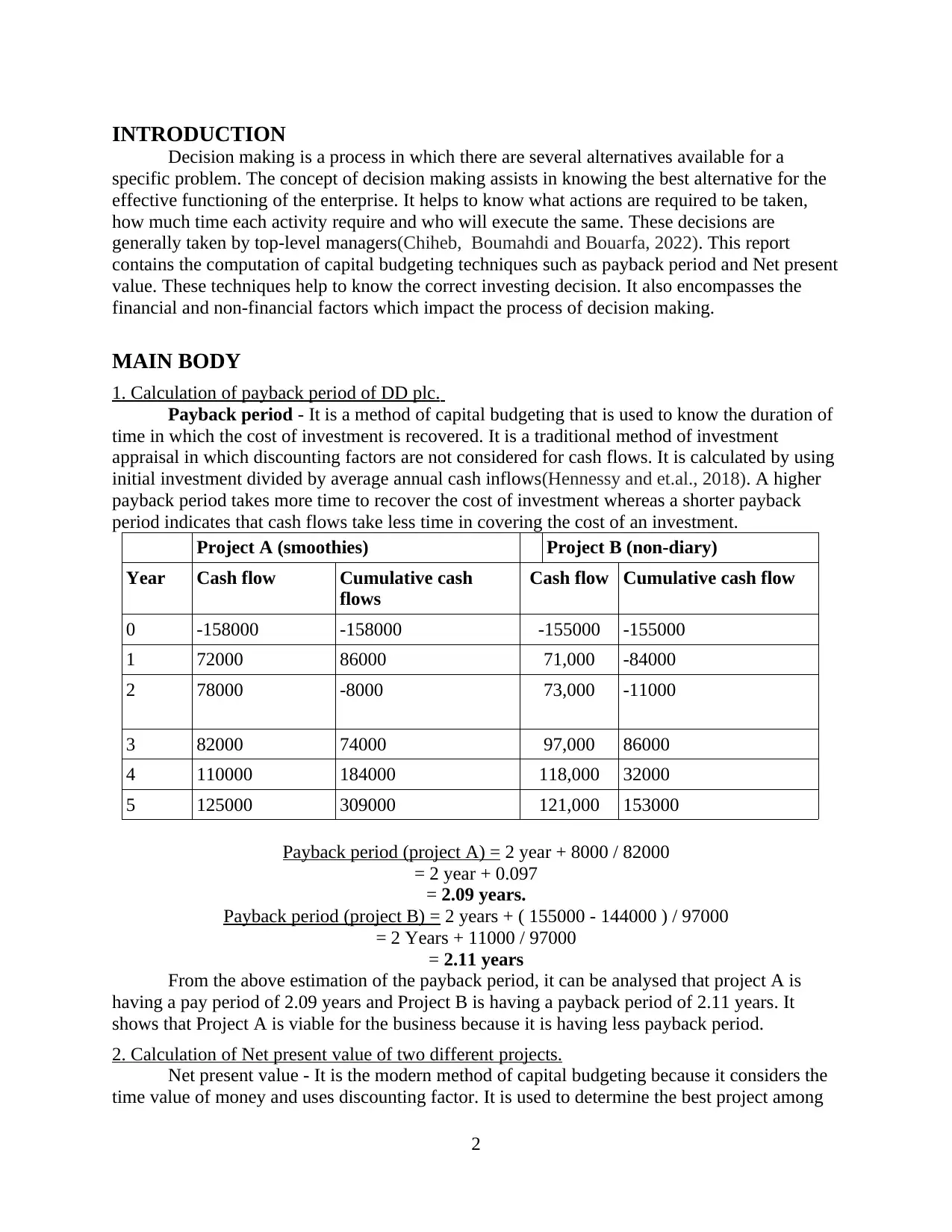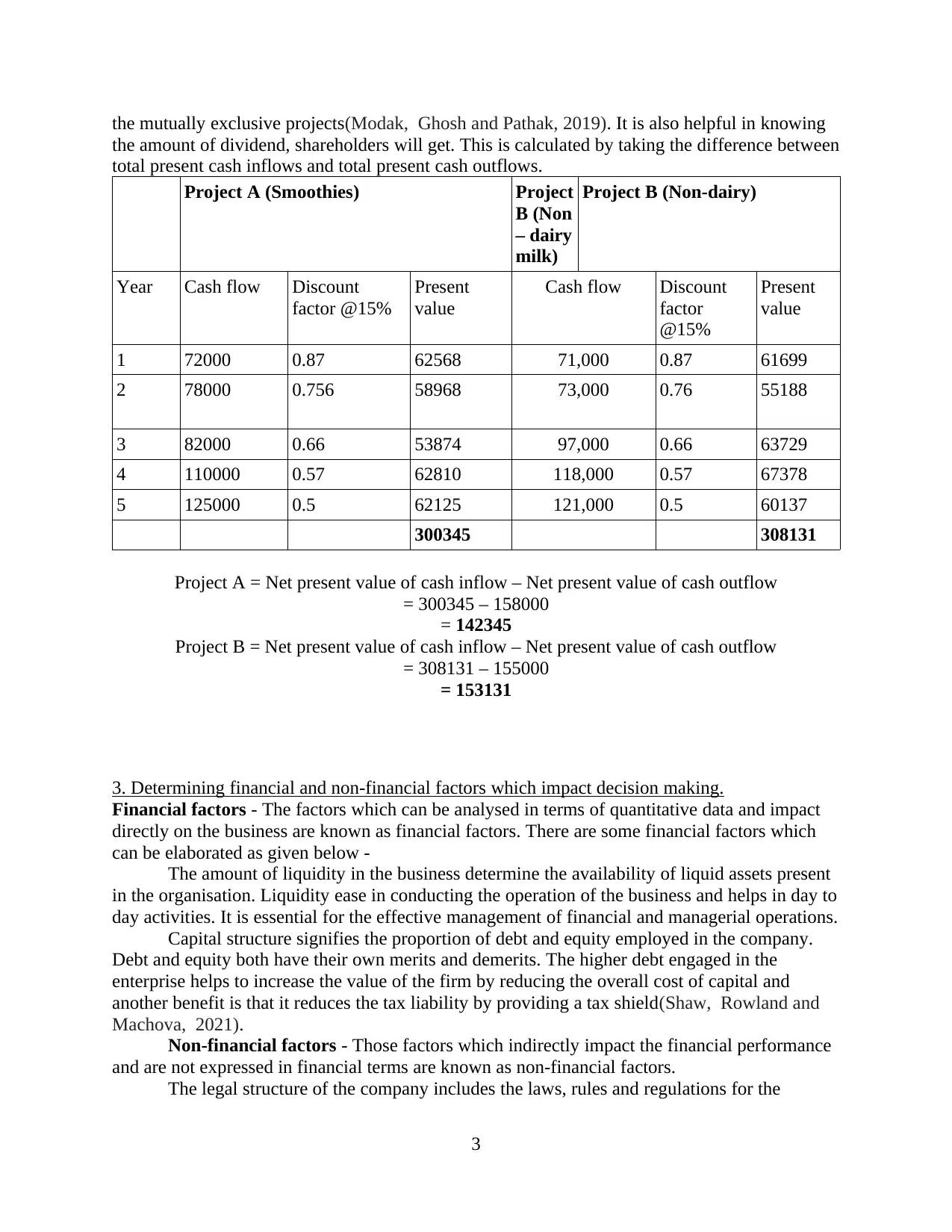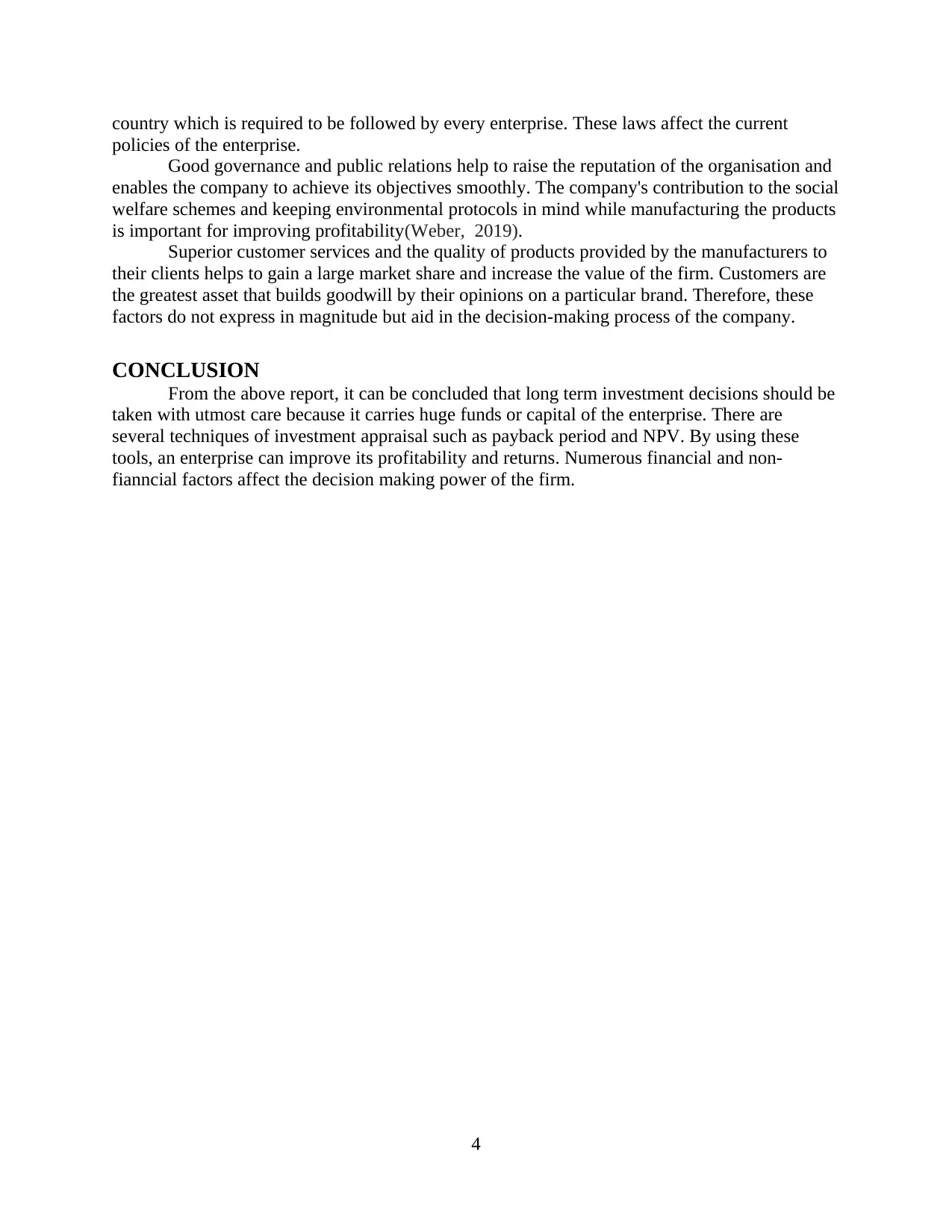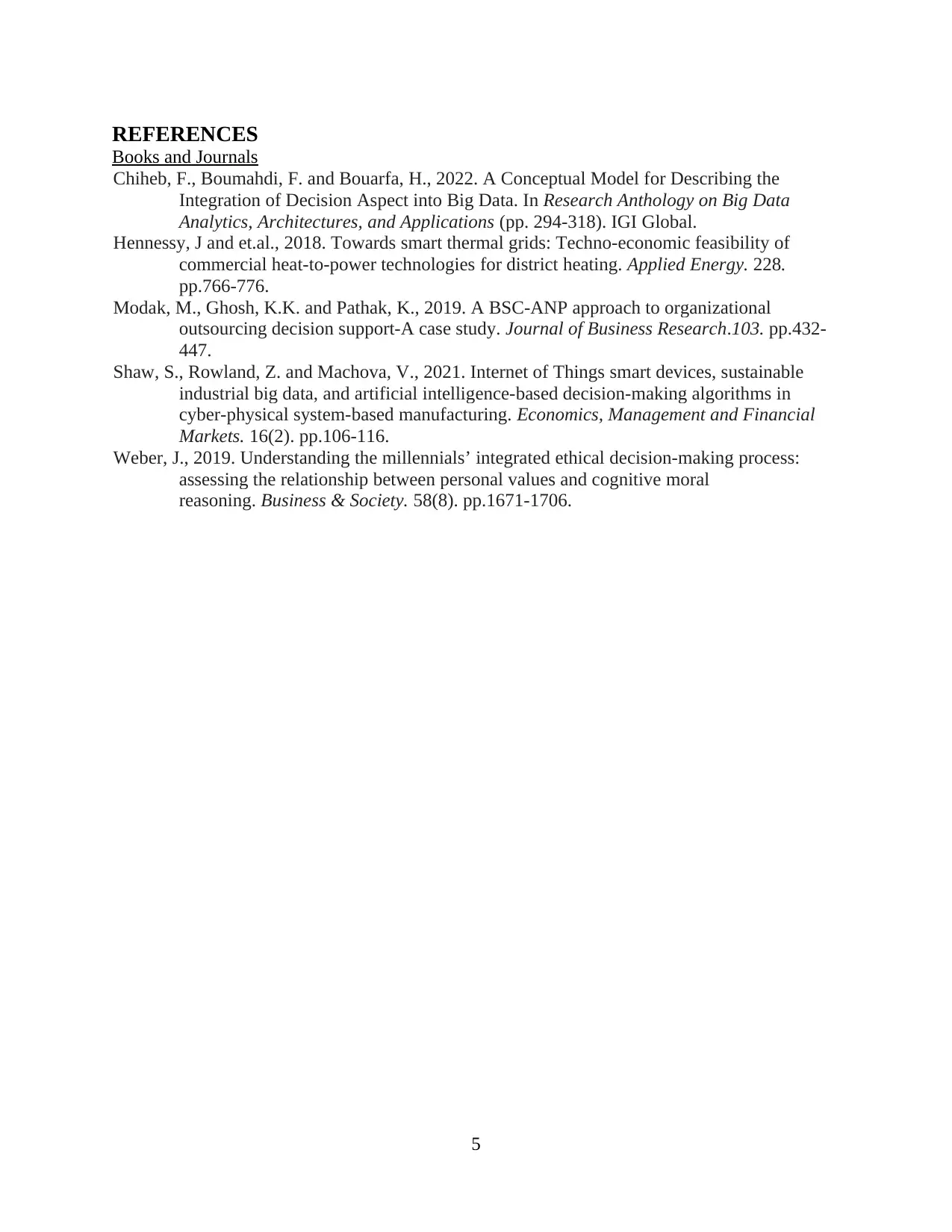Business Decision Making: Capital Budgeting Techniques and Key Factors
VerifiedAdded on 2023/06/14
|6
|1286
|219
Report
AI Summary
This report provides an analysis of business decision-making, focusing on capital budgeting techniques such as the payback period and Net Present Value (NPV). It includes calculations for the payback period of two projects, smoothies and non-dairy milk, determining that project A is more viable due to its shorter payback period. The report also calculates the NPV for both projects, highlighting their profitability. Furthermore, it identifies and discusses financial factors like liquidity and capital structure, as well as non-financial factors such as legal structure, governance, customer service, and product quality, all of which significantly impact the decision-making process within a business. The report concludes that long-term investment decisions require careful consideration and that utilizing investment appraisal techniques can improve profitability.

Business Decision
Making
Making
Paraphrase This Document
Need a fresh take? Get an instant paraphrase of this document with our AI Paraphraser

Table of Contents
INTRODUCTION...........................................................................................................................2
MAIN BODY...................................................................................................................................2
1. Calculation of payback period of DD plc...........................................................................2
2. Calculation of Net present value of two different projects.................................................3
3. Determining financial and non-financial factors which impact decision making..............4
CONCLUSION................................................................................................................................5
REFERENCES................................................................................................................................6
1
INTRODUCTION...........................................................................................................................2
MAIN BODY...................................................................................................................................2
1. Calculation of payback period of DD plc...........................................................................2
2. Calculation of Net present value of two different projects.................................................3
3. Determining financial and non-financial factors which impact decision making..............4
CONCLUSION................................................................................................................................5
REFERENCES................................................................................................................................6
1

INTRODUCTION
Decision making is a process in which there are several alternatives available for a
specific problem. The concept of decision making assists in knowing the best alternative for the
effective functioning of the enterprise. It helps to know what actions are required to be taken,
how much time each activity require and who will execute the same. These decisions are
generally taken by top-level managers(Chiheb, Boumahdi and Bouarfa, 2022). This report
contains the computation of capital budgeting techniques such as payback period and Net present
value. These techniques help to know the correct investing decision. It also encompasses the
financial and non-financial factors which impact the process of decision making.
MAIN BODY
1. Calculation of payback period of DD plc.
Payback period - It is a method of capital budgeting that is used to know the duration of
time in which the cost of investment is recovered. It is a traditional method of investment
appraisal in which discounting factors are not considered for cash flows. It is calculated by using
initial investment divided by average annual cash inflows(Hennessy and et.al., 2018). A higher
payback period takes more time to recover the cost of investment whereas a shorter payback
period indicates that cash flows take less time in covering the cost of an investment.
Project A (smoothies) Project B (non-diary)
Year Cash flow Cumulative cash
flows
Cash flow Cumulative cash flow
0 -158000 -158000 -155000 -155000
1 72000 86000 71,000 -84000
2 78000 -8000 73,000 -11000
3 82000 74000 97,000 86000
4 110000 184000 118,000 32000
5 125000 309000 121,000 153000
Payback period (project A) = 2 year + 8000 / 82000
= 2 year + 0.097
= 2.09 years.
Payback period (project B) = 2 years + ( 155000 - 144000 ) / 97000
= 2 Years + 11000 / 97000
= 2.11 years
From the above estimation of the payback period, it can be analysed that project A is
having a pay period of 2.09 years and Project B is having a payback period of 2.11 years. It
shows that Project A is viable for the business because it is having less payback period.
2. Calculation of Net present value of two different projects.
Net present value - It is the modern method of capital budgeting because it considers the
time value of money and uses discounting factor. It is used to determine the best project among
2
Decision making is a process in which there are several alternatives available for a
specific problem. The concept of decision making assists in knowing the best alternative for the
effective functioning of the enterprise. It helps to know what actions are required to be taken,
how much time each activity require and who will execute the same. These decisions are
generally taken by top-level managers(Chiheb, Boumahdi and Bouarfa, 2022). This report
contains the computation of capital budgeting techniques such as payback period and Net present
value. These techniques help to know the correct investing decision. It also encompasses the
financial and non-financial factors which impact the process of decision making.
MAIN BODY
1. Calculation of payback period of DD plc.
Payback period - It is a method of capital budgeting that is used to know the duration of
time in which the cost of investment is recovered. It is a traditional method of investment
appraisal in which discounting factors are not considered for cash flows. It is calculated by using
initial investment divided by average annual cash inflows(Hennessy and et.al., 2018). A higher
payback period takes more time to recover the cost of investment whereas a shorter payback
period indicates that cash flows take less time in covering the cost of an investment.
Project A (smoothies) Project B (non-diary)
Year Cash flow Cumulative cash
flows
Cash flow Cumulative cash flow
0 -158000 -158000 -155000 -155000
1 72000 86000 71,000 -84000
2 78000 -8000 73,000 -11000
3 82000 74000 97,000 86000
4 110000 184000 118,000 32000
5 125000 309000 121,000 153000
Payback period (project A) = 2 year + 8000 / 82000
= 2 year + 0.097
= 2.09 years.
Payback period (project B) = 2 years + ( 155000 - 144000 ) / 97000
= 2 Years + 11000 / 97000
= 2.11 years
From the above estimation of the payback period, it can be analysed that project A is
having a pay period of 2.09 years and Project B is having a payback period of 2.11 years. It
shows that Project A is viable for the business because it is having less payback period.
2. Calculation of Net present value of two different projects.
Net present value - It is the modern method of capital budgeting because it considers the
time value of money and uses discounting factor. It is used to determine the best project among
2
⊘ This is a preview!⊘
Do you want full access?
Subscribe today to unlock all pages.

Trusted by 1+ million students worldwide

the mutually exclusive projects(Modak, Ghosh and Pathak, 2019). It is also helpful in knowing
the amount of dividend, shareholders will get. This is calculated by taking the difference between
total present cash inflows and total present cash outflows.
Project A (Smoothies) Project
B (Non
– dairy
milk)
Project B (Non-dairy)
Year Cash flow Discount
factor @15%
Present
value
Cash flow Discount
factor
@15%
Present
value
1 72000 0.87 62568 71,000 0.87 61699
2 78000 0.756 58968 73,000 0.76 55188
3 82000 0.66 53874 97,000 0.66 63729
4 110000 0.57 62810 118,000 0.57 67378
5 125000 0.5 62125 121,000 0.5 60137
300345 308131
Project A = Net present value of cash inflow – Net present value of cash outflow
= 300345 – 158000
= 142345
Project B = Net present value of cash inflow – Net present value of cash outflow
= 308131 – 155000
= 153131
3. Determining financial and non-financial factors which impact decision making.
Financial factors - The factors which can be analysed in terms of quantitative data and impact
directly on the business are known as financial factors. There are some financial factors which
can be elaborated as given below -
The amount of liquidity in the business determine the availability of liquid assets present
in the organisation. Liquidity ease in conducting the operation of the business and helps in day to
day activities. It is essential for the effective management of financial and managerial operations.
Capital structure signifies the proportion of debt and equity employed in the company.
Debt and equity both have their own merits and demerits. The higher debt engaged in the
enterprise helps to increase the value of the firm by reducing the overall cost of capital and
another benefit is that it reduces the tax liability by providing a tax shield(Shaw, Rowland and
Machova, 2021).
Non-financial factors - Those factors which indirectly impact the financial performance
and are not expressed in financial terms are known as non-financial factors.
The legal structure of the company includes the laws, rules and regulations for the
3
the amount of dividend, shareholders will get. This is calculated by taking the difference between
total present cash inflows and total present cash outflows.
Project A (Smoothies) Project
B (Non
– dairy
milk)
Project B (Non-dairy)
Year Cash flow Discount
factor @15%
Present
value
Cash flow Discount
factor
@15%
Present
value
1 72000 0.87 62568 71,000 0.87 61699
2 78000 0.756 58968 73,000 0.76 55188
3 82000 0.66 53874 97,000 0.66 63729
4 110000 0.57 62810 118,000 0.57 67378
5 125000 0.5 62125 121,000 0.5 60137
300345 308131
Project A = Net present value of cash inflow – Net present value of cash outflow
= 300345 – 158000
= 142345
Project B = Net present value of cash inflow – Net present value of cash outflow
= 308131 – 155000
= 153131
3. Determining financial and non-financial factors which impact decision making.
Financial factors - The factors which can be analysed in terms of quantitative data and impact
directly on the business are known as financial factors. There are some financial factors which
can be elaborated as given below -
The amount of liquidity in the business determine the availability of liquid assets present
in the organisation. Liquidity ease in conducting the operation of the business and helps in day to
day activities. It is essential for the effective management of financial and managerial operations.
Capital structure signifies the proportion of debt and equity employed in the company.
Debt and equity both have their own merits and demerits. The higher debt engaged in the
enterprise helps to increase the value of the firm by reducing the overall cost of capital and
another benefit is that it reduces the tax liability by providing a tax shield(Shaw, Rowland and
Machova, 2021).
Non-financial factors - Those factors which indirectly impact the financial performance
and are not expressed in financial terms are known as non-financial factors.
The legal structure of the company includes the laws, rules and regulations for the
3
Paraphrase This Document
Need a fresh take? Get an instant paraphrase of this document with our AI Paraphraser

country which is required to be followed by every enterprise. These laws affect the current
policies of the enterprise.
Good governance and public relations help to raise the reputation of the organisation and
enables the company to achieve its objectives smoothly. The company's contribution to the social
welfare schemes and keeping environmental protocols in mind while manufacturing the products
is important for improving profitability(Weber, 2019).
Superior customer services and the quality of products provided by the manufacturers to
their clients helps to gain a large market share and increase the value of the firm. Customers are
the greatest asset that builds goodwill by their opinions on a particular brand. Therefore, these
factors do not express in magnitude but aid in the decision-making process of the company.
CONCLUSION
From the above report, it can be concluded that long term investment decisions should be
taken with utmost care because it carries huge funds or capital of the enterprise. There are
several techniques of investment appraisal such as payback period and NPV. By using these
tools, an enterprise can improve its profitability and returns. Numerous financial and non-
fianncial factors affect the decision making power of the firm.
4
policies of the enterprise.
Good governance and public relations help to raise the reputation of the organisation and
enables the company to achieve its objectives smoothly. The company's contribution to the social
welfare schemes and keeping environmental protocols in mind while manufacturing the products
is important for improving profitability(Weber, 2019).
Superior customer services and the quality of products provided by the manufacturers to
their clients helps to gain a large market share and increase the value of the firm. Customers are
the greatest asset that builds goodwill by their opinions on a particular brand. Therefore, these
factors do not express in magnitude but aid in the decision-making process of the company.
CONCLUSION
From the above report, it can be concluded that long term investment decisions should be
taken with utmost care because it carries huge funds or capital of the enterprise. There are
several techniques of investment appraisal such as payback period and NPV. By using these
tools, an enterprise can improve its profitability and returns. Numerous financial and non-
fianncial factors affect the decision making power of the firm.
4

REFERENCES
Books and Journals
Chiheb, F., Boumahdi, F. and Bouarfa, H., 2022. A Conceptual Model for Describing the
Integration of Decision Aspect into Big Data. In Research Anthology on Big Data
Analytics, Architectures, and Applications (pp. 294-318). IGI Global.
Hennessy, J and et.al., 2018. Towards smart thermal grids: Techno-economic feasibility of
commercial heat-to-power technologies for district heating. Applied Energy. 228.
pp.766-776.
Modak, M., Ghosh, K.K. and Pathak, K., 2019. A BSC-ANP approach to organizational
outsourcing decision support-A case study. Journal of Business Research.103. pp.432-
447.
Shaw, S., Rowland, Z. and Machova, V., 2021. Internet of Things smart devices, sustainable
industrial big data, and artificial intelligence-based decision-making algorithms in
cyber-physical system-based manufacturing. Economics, Management and Financial
Markets. 16(2). pp.106-116.
Weber, J., 2019. Understanding the millennials’ integrated ethical decision-making process:
assessing the relationship between personal values and cognitive moral
reasoning. Business & Society. 58(8). pp.1671-1706.
5
Books and Journals
Chiheb, F., Boumahdi, F. and Bouarfa, H., 2022. A Conceptual Model for Describing the
Integration of Decision Aspect into Big Data. In Research Anthology on Big Data
Analytics, Architectures, and Applications (pp. 294-318). IGI Global.
Hennessy, J and et.al., 2018. Towards smart thermal grids: Techno-economic feasibility of
commercial heat-to-power technologies for district heating. Applied Energy. 228.
pp.766-776.
Modak, M., Ghosh, K.K. and Pathak, K., 2019. A BSC-ANP approach to organizational
outsourcing decision support-A case study. Journal of Business Research.103. pp.432-
447.
Shaw, S., Rowland, Z. and Machova, V., 2021. Internet of Things smart devices, sustainable
industrial big data, and artificial intelligence-based decision-making algorithms in
cyber-physical system-based manufacturing. Economics, Management and Financial
Markets. 16(2). pp.106-116.
Weber, J., 2019. Understanding the millennials’ integrated ethical decision-making process:
assessing the relationship between personal values and cognitive moral
reasoning. Business & Society. 58(8). pp.1671-1706.
5
⊘ This is a preview!⊘
Do you want full access?
Subscribe today to unlock all pages.

Trusted by 1+ million students worldwide
1 out of 6
Related Documents
Your All-in-One AI-Powered Toolkit for Academic Success.
+13062052269
info@desklib.com
Available 24*7 on WhatsApp / Email
![[object Object]](/_next/static/media/star-bottom.7253800d.svg)
Unlock your academic potential
Copyright © 2020–2025 A2Z Services. All Rights Reserved. Developed and managed by ZUCOL.


